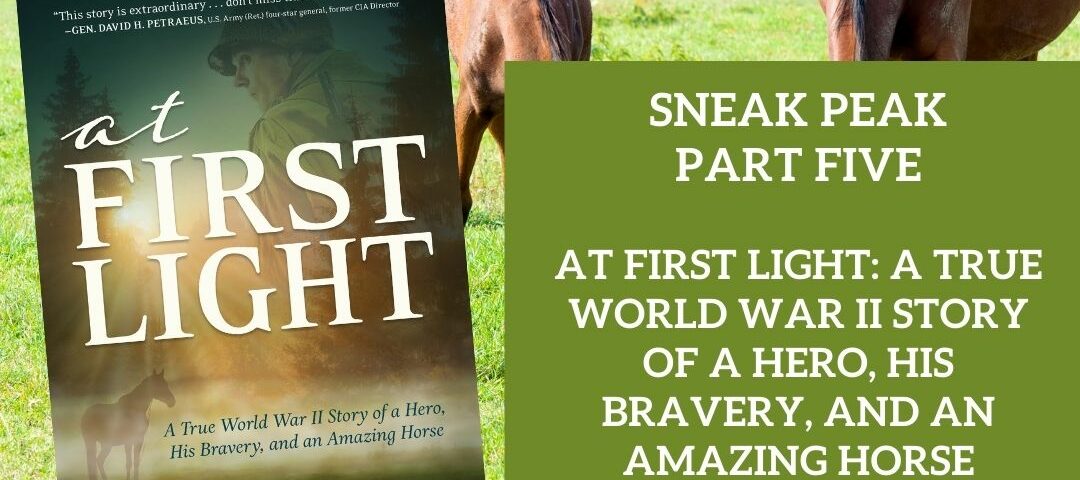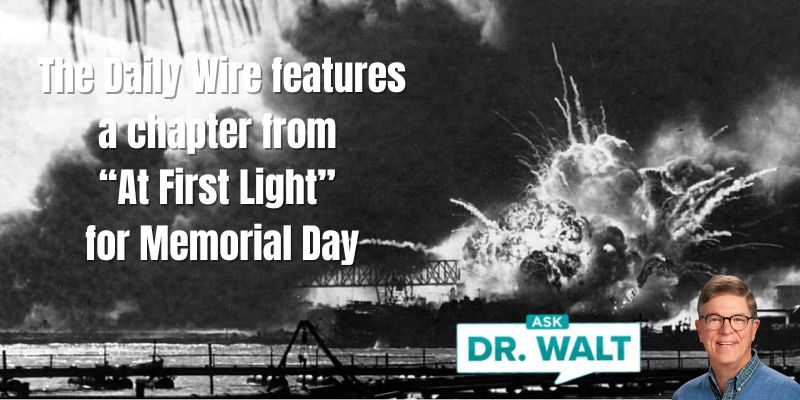
Obesity nearly doubles a woman’s risk of endometrial cancer
April 29, 2022
Monthly Family Update – May 2022
May 1, 2022SNEAK PEAK – Part Five – At First Light: A True World War II Story of a Hero, His Bravery, and an Amazing Horse
With the permission of my publisher, for the month of April, I’m giving you a SNEAK PEEK of the first five chapters of my latest book — a wonderful story about my father’s heroism and exploits before and after World War II. Here’s CHAPTER FOUR of At First Light: A True World War II Story of a Hero, His Bravery, and an Amazing Horse.
“At First Light is one of the most fascinating stories of World War II I have ever read. If you love history like I do, this book is a must read. Near the end of the war, a courageous young US Army officer, Phil Larimore, is given an almost impossible clandestine mission—to find Hitler’s hidden Lipizzaners so they can be saved. Don’t miss this heartwarming true story of a great American hero.”
—Lt. Gen. William G. Boykin, U.S. Army (Ret.) three-star general, former Undersecretary of Defense for Intelligence under President George W. Bush, and former Commander Delta Force and U.S. Army Special Operations Command
Order Here
CHAPTER FOUR
ON TO BENNING
“Now to the Infantry … the mud-rain-frost-and-wind boys. They have no comforts, and they even learn to live without the necessities. And in the end, they are the guys that wars can’t be won without.”
—Ernie Pyle, American journalist and war correspondent
On September 10, 1942, instead of heading to college, Phil told his parents goodbye in Memphis and traveled back to Gulfport to spend a few days with Marilyn. His girlfriend was continuing her education at Gulf Park College. Before they knew it, their time together raced to an end. They embraced for one long hug and a kiss under the Friendship Oak before he boarded a Greyhound bus heading to Infantry Officer Candidate School (OCS) at Fort Benning, Georgia.
Upon arrival, he and 199 other candidates formed four platoons of fifty men each, and each platoon was assigned to one of four two-story barracks. All four platoons had a Tactical Officer (TO), also known as the platoon’s TAC (Teach, Access, and Counsel) Officer. In Phil’s case, the TAC was a 1st lieutenant who was not only in charge of the platoon’s training, but he would be able to choose which of the men would be commissioned as officers. As Russell Cloer, another OCS candidate from Jersey City, New Jersey, said, “In other words, he was God for the duration of our stay!”
The TOs’ pith-style helmets had an Infantry School insignia front and center that read Follow Me, the motto of the Infantry School, which was also nicknamed “Benning’s School for Boys.” At their first formation, Phil’s platoon was told that fewer than half would graduate while the rest would “wash out.” He had no way of knowing that this was an exaggeration intended to motivate the men, but it worked: Phil determined that failure was not an option. He was also aware that he was the youngest in his class.
A typical day involved the men being awakened before sunrise, usually at either 4 a.m. or, more commonly, 5 a.m., by a bugler playing “Reveille.” The recruits were given enough time to “shit, shower, and shave” and wolf down a quick breakfast before falling into formation and being trucked to the day’s training area. The officer candidates had to perform no mundane duties—just training, training, training.
For most men, their OCS physical and mental exercises were grueling, but Phil found the drilling and physical workouts to be surprisingly gratifying. He was in much better shape than most of his classmates, and although a fair share had more intellectual prowess, few could match how quickly he learned, how expertly he handled small arms, rifles, and marksmanship, or how skillfully he could lead men when called upon to do so.
The officer candidates had free time every Saturday afternoon and all day Sunday. Many of the guys would put on their uniforms, with the required OCS patch sewed to their shirt pocket, and take a bus six miles into the nearest town, Columbus. Phil, however, occupied his free time either studying or writing home to his parents and Marilyn. On Saturday and Sunday evenings, he would treat himself to a movie at the theater on the post.
But once Phil learned about the Fort Benning Hunt Club, an on-base stable, he could be found there on most weekends. The first time he walked through the barn, he carefully looked at each mount. A bay-colored Thoroughbred mare seemed to respond to him. As he approached her, she whinnied, shook her head in approval, and walked across the stall to let him gently rub her nose.
“She’s a beaut,” one of the passing grooms commented. “Rita Hayworth she’s called, after the movie star. Lotta the guys like riding Rita, or at least writing home and saying they did,” the groom chuckled.
For the weekends that followed, Phil and Rita were inseparable. Phil believed, as did British Prime Minister Winston Churchill, that “No hour of life is wasted that is spent in the saddle.” He and Rita not only swept nearly all the on-base equestrian events, but it was at Fort Benning that Phil experienced his first foxhunt.
The hunt used a pack of American Foxhounds maintained with the assistance of the Army MWR (Morale, Welfare and Recreation) Division. A retired colonel who served as the Master of the Foxhounds invited Phil to his first hunt and introduced him to the most recognized tradition of foxhunting—the distinctive attire.
Working out of a closet owned by the club, the distinguished gentleman had Phil try on several outfits until he had the perfect fit for a scarlet jacket, beige jodhpurs (or riding pants), tall black boots, and the traditional black top hat. The brightly colored coat’s primary purpose was to ensure that riders were not mistaken for prey and shot as they chased their quarry through the woods, the colonel explained.
As the colonel helped Phil into his overcoat, he said, “Traditionally, only the Hunt Club members get to wear the red coat, which is called a pink, but in your case, the Master of the Foxhunt gives permission.”
Phil smiled. “Thanks, Colonel.”
“You’ve earned it, son. I’ve seen you ride and jump. As for these tight-fitting britches, they reduce the chance of getting caught up in branches or brambles, and the tall boots protect your legs from scratches and scrapes.”
“Thanks for the explanation. What game do you chase?”
“The game for our hunts is usually a coyote. The hunt area here at the post is so large and rugged that the game rarely has any trouble eluding the hounds and the hunt field. It’s not considered sporting to kill the game. What we love are the pure joy and sport of the hunt—and the chase. And,” he added, “the social time after the hunt is a wonderful time to meet folks from all around the post and the surrounding area.”
Phil and Rita both loved the hunts—the galloping and jumping. Although many of the less-experienced riders fell during jumps over creeks, logs, or narrow ravines, Phil and Rita were both expert jumpers and nearly always at the front of the pack. The colonel often told him, “Horses lend us the wings we lack.” And, as the colonel had predicted, the social hours after the hunt were always an enjoyable time to share drinks and stories.
Having spent four years in military school, Phil did not wrestle with homesickness as some of the men did, but he desperately missed Marilyn. Fortunately, the Southern Bell Telephone Company’s phone room allowed the men to call home and their gals once a week for no charge. Of course, he wrote her as often as he could.
For Phil, the exhilaration of riding on weekends and the military instruction during the week combined to make the time fly.
Order Here
© Copyright WLL, INC. 2022.





